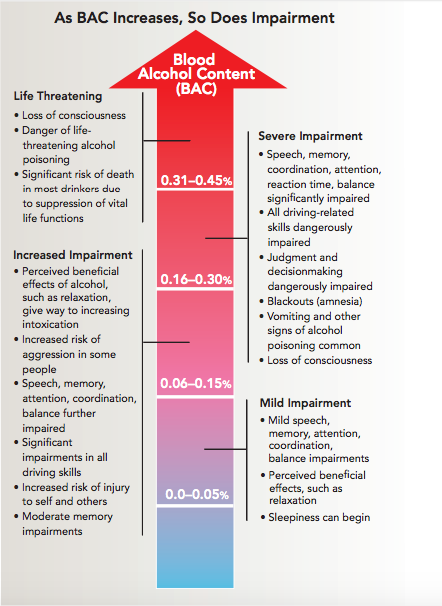Blood-alcohol content (BAC) levels are frequently part of news reports about charges of driving under the influence. Here’s some insight into why they’re used by police and prosecutors.
The National Institute on Alcohol Abuse and Alcoholism published the chart below showing possible impairment levels from various BACs in a pamphlet. But impairment can vary quite a bit from person to person, as the pamphlet points out:
“What tips the balance from drinking that has pleasant effects to drinking that can cause harm varies among individuals. Age, drinking experience, gender, the amount of food eaten, even ethnicity all can influence how much is too much.”

From the "Alcohol Overdose: The Dangers of Drinking Too Much" pamphlet of the NIAAA
From “Alcohol Overdose: The Dangers of Drinking Too Much” an NIAAA pamphlet
Over Drinking: Rough Guidelines

"Alcohol Overdose: The Dangers of Drinking Too Much" an NIAAA pamphlet
“Binge drinking for women is having 4 or more drinks within 2 hours; for men, it is 5 or more drinks within 2 hours. This dangerous pattern of drinking typically results in a BAC of .08% for the average adult and increases the risk of immediate adverse consequences.” — from the NIAAA pamphlet
These charts are from the pamphlet “Alcohol Overdose: The Dangers of Drinking Too Much” published by the National Institute on Alcohol Abuse and Alcoholism (NIAAA), a part of National Institutes of Health, a federal agency.

Pingback: Police: DUI for Man, 28, Driving West on Eastbound Side of Post Road - DarieniteDarienite
Pingback: Police: DUI for Woman, 33, Driving So Slow That Traffic Was Backing Up Behind Her — at 1:20 AM - DarieniteDarienite